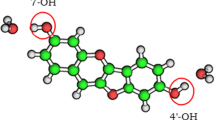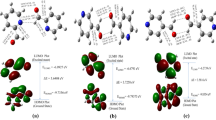Abstract
The difluorocarbene radical (:CF2), used in organic synthesis and in photoaffinity labeling, can be generated by the pyrolytic or photolytic decomposition of 3,3-difluorodiazirine (CF2N2, DFD). DFD possesses no dipole moment in the ground electronic state S 0 but has an experimental dipole of 1.5 ± 0.2 debye (D) in its first singlet excited state S 1. These observations have been ascribed to the shift in electron population between orbitals (Frenking et al. in J Comp Chem 28:117–126, 2007). An alternative real-space explanation is presented, which shows that the vanishing dipole moment in S 0 results from a balance between a charge transfer contribution due to the flow of charge between atoms and an atomic polarization term due to the non-sphericity of atoms in molecules. This balance is altered in S 1. This orbital-free description is shown to be consistent with an incipient dissociation of DFD to :CF2 and N2 upon excitation. The Laplacian of the electron density and the molecular electrostatic potential exhibit significant reorganization on excitation, mirroring one another, with consequential changes in chemical reactivity. Conforming to Hund’s rule, the lowest excited state is a triplet state (T 1), and the next level, the one examined in this work, is the first singlet excited state (S 1) with vertical excitation energies of 2.81 and 3.99 eV, respectively. The calculated dipole moment magnitudes (in D) are 0.05 (S 0), 0.973 (T 1), and 0.969 (S 1) all pointing their negative end toward the nitrogens. The maximal average lifetime of S 1 (in absence of non-radiative de-excitation) is ca. 30 ps, sufficient for its slowest vibrational normal mode to complete 400 oscillations. From a comparison of Hartree–Fock, MP2, QCISD, CCSD, and TD-DFT/B3LYP calculations with experiment (all using an aug-cc-pVTZ basis set), for both the ground and excited states of DFD, the method of choice appears to be QCISD, the one used in this work.








Similar content being viewed by others
References
Mitsch RA (1965) J Am Chem Soc 87:758–761
Mitsch RA (1964) J Heterocycl Chem 1:271–274
Dubinsky L, Krom BP, Meijler MM (2012) Bioorg Med Chem 20:554–570
Bjork CW, Craig NC, Mitsch RA, Overend J (1965) J. Am. Chem. Soc. 87; 1186–1191 (captions of Figs. 1 and 2 in this reference should be switched as described in a correction by the authors in a citation of this article as Ref. [1], p. 897, in: Norman CR, Kliewer MA (1979) Spectrochim. Acta 35A; 895–897)
Douglas MM (1966) United States Patent US3257381A
Moss RA, Wang L, Krogh-Jespersen K (2009) J Am Chem Soc 131:2128–2130
Bogey M, Winnewisser M, Christiansen JJ (1984) Can J Phys 62:1198–1216
Hencher JL, Bauer SH (1967) J Am Chem Soc 89:5527–5531
Craig NC, Kliewer MA (1979) Spectrochim Acta A 35A:895–897
Sieber H, Neusser HJ, Stroh F, Winnewisser M (1991) J Mol Spectr 148:453–461
Pandey RR, Khait YG, Hoffmann MR (2004) J Phys Chem A 108:3119–3124
Sieber H, Riedle E, Neusser HJ (1990) Chem Phys Lett 169:191–197
Lombardi JR, Klemperer W, Robin MB, Basch H, Kuebler NA (1969) J Chem Phys 51:33–44
Hollas JM, Hepburn PH (1974) J Mol Spect 50:126–141
Hollas JM (1982) High resolution spectroscopy. Butterworths, London
Pauling L (1960) The nature of the chemical bond, 3rd edn. Cornell University Press, Ithaca
Pople JA, Head-Gordon M, Raghavachari K (1987) J Chem Phys 87:5968–5975
Bader RFW (1990) Atoms in molecules: a quantum theory. Oxford University Press, Oxford
Popelier PLA (2000) Atoms in molecules: an introduction. Prentice Hall, London
Matta CF, Boyd RJ (eds) (2007) The quantum theory of atoms in molecules: from solid state to dna and drug design. Wiley-VCH, Weinheim
Hovick JW, Poler JC (2005) J Chem Educ 82:889
Coulson CA (1961) Electricity. Oliver and Boyd, London
Turro NJ (1991) Modern molecular photochemistry. University Science Books, Sausalito
Simmons JD, Bartky IR, Bass AM (1965) J Mol Spectrosc 17:48–49
Bakhsliev NG, Knyazhanskii MI, Minkin VI, Osipov OA, Saidov GV (1969) Russ Chem Rev 38:740–754
Bader RFW, Bayles D, Heard GL (2000) J Chem Phys 112:10095–10105
Buttingsrud B, Alsberg BK, Åstrand P-O (2007) Phys Chem Chem Phys 9:2226–2233
Gutiérrez-Arzaluz L, Cortés-Guzmán F, Rocha-Rinza T, Peón J (2015) Phys Chem Chem Phys (PCCP) 17:31608–31612
Jenkins S, Blancafort L, Kirk SR, Bearpark MJ (2014) Phys Chem Chem Phys (PCCP) 16:7115–7126
Sánchez-Flores EI, Chávez-Calvillo R, Keith TA, Cuevas G, Rocha-Rinza T, Cortés-Guzmán F (2014) J Comput Chem 35:820–828
Jara-Cortés J, Rocha-Rinza T, Hernández-Trujillo J (2015) Comput Theor Chem 1053:220–228
Syrkin YK, Dyatkina ME (1964) Structure of molecules and the chemical bond (english translation). Dover Publications Inc, New York
Davies M (1965) Some electrical and optical aspects of molecular behaviour. Pergamon Press, Oxford
Laidig KE, Bader RFW (1990) J Chem Phys 93:7213–7224
Bader RFW, Keith TA (1993) J Chem Phys 99:3683–3693
Bader RFW (2002) Mol Phys 100:3333–3344
Bader RFW, Matta CF (2001) Int J Quantum Chem 85:592–607
Matta CF, Sowlati-Hashjin S, Bandrauk AD (2013) J Phys Chem A 117:7468–7483
Keith TA (2007) Chapter 3. In: Matta CF, Boyd RJ (eds) The quantum theory of atoms in molecules: from solid state to DNA and drug design. Wiley-VCH, Weinheim
Dunning TH (1989) J Chem Phys 90:1007–1023
Szabo A, Ostlund NS (1989) Modern quantum chemistry: introduction to advanced electronic structure theory. Dover Publications Inc, New York
Møller C, Plesset MS (1934) Phys Rev 46:618–622
Scuseria GE, Janssen CL, Schaefer HF III (1988) J Chem Phys 89:7382–7387
Purvis GD III, Bartlett RJ (1982) J Chem Phys 76:1910–1918
Shavitt I, Bartlett RJ (2009) Many-body methods in chemistry and physics: mbpt and coupled-cluster theory. Cambridge University Press, Cambridge
Parr RG, Yang W (1989) Density-functional theory of atoms and molecules. Oxford University Press, Oxford
Koch W, Holthausen MC (2001) A chemist’s guide to density functional theory, 2nd edn. Wiley-VCH, New York
Becke A (1993) J Chem Phys 98:5648–5652
Lee C, Yang W, Parr R (1988) Phys Rev B 37:785–789
Jablonski M, Palusiak M (2010) J Phys Chem A 114:12498–12505
Rykounov AA, Tsirelson VG (2009) J Mol Struct (Theochem) 906:11–24
Matta CF (2010) J Comput Chem 31:1297–1311
Frisch MJ, Trucks GW, Schlegel HB, Scuseria GE, Robb MA, Cheeseman JR, Scalmani G, Barone V, Mennucci B, Petersson GA, Nakatsuji H, Caricato M, Li X, Hratchian HP, Izmaylov AF, Bloino J, Zheng G, Sonnenberg JL, Hada M, Ehara M, Toyota K, Fukuda R, Hasegawa J, Ishida M, Nakajima T, Honda Y, Kitao O, Nakai H, Vreven T, Montgomery Jr JA, Peralta JE, Ogliaro F, Bearpark M, Heyd JJ, Brothers E, Kudin KN, Staroverov VN, Keith T, Kobayashi R, Normand J, Raghavachari K, Rendell A, Burant JC, Iyengar SS, Tomasi J, Cossi M, Rega N, Millam JM, Klene M, Knox JE, Cross JB, Bakken V, Adamo C, Jaramillo J, Gomperts R, Stratmann RE, Yazyev O, Austin AJ, Cammi R, Pomelli C, Ochterski JW, Martin RL, Morokuma K, Zakrzewski VG, Voth GA, Salvador P, Dannenberg JJ, Dapprich S, Daniels AD, Farkas O, Foresman JB, Ortiz JV, Cioslowski J, Fox DJ (2010) Gaussian 09, Revision B.01. Gaussian Inc.: Wallingford CT
Keith TA (2015) AIMAll/AIMStudio (http://aim.tkgristmill.com/)
Frenking G, Loschen C, Krapp A, Fau S, Strauss SH (2007) J Comp Chem 28:117–126
Kim H, Doan VD, Cho WJ, Valero R, Tehrani ZA, Madridejos JML, Kim KS (2015) Sci Rep 5:16307
Matta CF, Gillespie RJ (2002) J Chem Educ 79:1141–1152
Bader RFW, Zou PF (1992) Chem Phys Lett 191:54–58
Bader RFW, Matta CF (2004) J Phys Chem A 108:8385–8394
Tsirelson VG, Ozerov RP (1996) Electron density and bonding in crystals: principles, theory and x-ray diffraction experiments in solid state physics and chemistry. Institute of Physics Publishing, New York
Koritsanszky TS, Coppens P (2001) Chem Rev 101:1583–1628
Coppens P (1997) X-ray charge densities and chemical bonding. Oxford University Press Inc, New York
Sturm JE (1990) J Chem Educ 67:32–33
Bader RFW (2000) Coord Chem Rev 197:71–94
Bader RWF, Heard GL (1999) J Chem Phys 111:8789–8797
National Institute of Standards and Technology (NIST) (2015) Computational Chemistry Comparison and Benchmark DataBase: Precomputed vibrational scaling factors (http://cccbdb.nist.gov/vibscale.asp)
Avendaño M, Cordova T, Mora JR, Chuchani G (2016) Comput Theor Chem 1078:23–29
Acknowledgments
The authors thank the two anonymous reviewers especially Reviewer #1 who suggested the examination of the Laplacian scalar field and its change upon excitation. The authors also thank Professor Lou Massa (Hunter College, City University of New York), Professor Paul W. Ayers (McMaster University), and Drs. Jim Hess and Douglas J. Fox of Gaussian, Inc., for helpful comments. L.A.T. thanks CAPES for a doctoral fellowship and CNPq (Science without Borders Scholarship Program—205445/2014-4) and for a Visiting Graduate Studentship at Mount Saint Vincent University. R. L. A. H thanks FAPESP for financial support (Grants 2014/23714-1 and 2010/18743-1, São Paulo Research Foundation). C. F. M. acknowledges the funding of the Natural Sciences and Engineering Research Council of Canada (NSERC), Canada Foundation for Innovation (CFI), and Mount Saint Vincent University for financial support.
Author information
Authors and Affiliations
Corresponding author
Additional information
Published as part of the special collection of articles “CHITEL 2015 - Torino - Italy”.
Rights and permissions
About this article
Cite this article
Terrabuio, L.A., Haiduke, R.L.A. & Matta, C.F. Difluorodiazirine (CF2N2): a quantum mechanical study of the electron density and of the electrostatic potential in the ground and excited electronic states. Theor Chem Acc 135, 63 (2016). https://doi.org/10.1007/s00214-015-1803-7
Received:
Accepted:
Published:
DOI: https://doi.org/10.1007/s00214-015-1803-7




